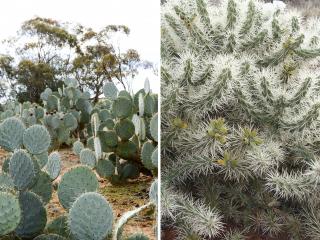Landholders across Western Australia are urged to be on the lookout during November for cacti that pose a threat to agricultural land and to report any infestations.
The Department of Agriculture and Food is building awareness this month about opuntioid cacti, a sub-family of cactus that competes with native vegetation and poses a risk to livestock.
The call to report infestations comes as seven community groups from across the State received funding totalling $135,000 to support efforts to respond to local cacti infestations and build capacity to manage them.
Department Invasive Species manager Kay Bailey said the groups were targeting weed infestations in the rangelands, Grainbelt and south coast.
“Commonwealth funding, administered by the department, is supporting the control of these high priority Weeds of National Significance,” Ms Bailey said.
“Control and eradication activities range from biological control, using cactoblastis moths and cochineal insects, to mechanical removal and chemical spraying or injecting techniques.”
Ms Bailey said 23 different species of opuntioid cacti had been recorded in WA.
“These are declared pests under the Biosecurity and Agriculture Management Act 2007, requiring landholders to control these pests on their properties,” she said.
“Opuntioid cacti can form dense thickets with long spines, which become impenetrable and can be harmful to livestock and native fauna.”
Ms Bailey said compared with other states, WA had a relatively low number of known infestations.
“This presents a good opportunity to halt the spread and even locally eradicate many infestations,” she said.
“We first need to know the extent of their distribution – this is where everyone can play a part.
“We are reminding people when they are out and about, to keep an eye out. Common places to find declared cactus include old homesteads, gardens in older neighbourhoods and nurseries.”
The top five priority cactus varieties in WA are jumping cholla (Cylindropuntia prolifera), Hudson pear (white-spined) (Cylindropuntia rosea), wheel cactus (Opuntia robusta), devil’s rope (Cylindropuntia imbricata) and coral cactus (Cylindropuntia fulgida var. mamillata).
Reports can be made using the department’s MyWeedWatcher web page, where an app reporting option is available. Further information about the app is available on the department’s website.
For more catcus information visit agric.wa.gov.au/cactus or contact the department’s Pest and Disease Information Service on freecall 1800 084 881.
Additional information:
Coordinated Cactus Campaign – funding recipients
Esperance Weeds Action Group, $19,075 to target prickly pear
North Mallee Farm Improvement Group, $20,000 to target prickly pear
Shire of Kellerberrin, $16,138 to target prickly pear and wheel cactus
Meekatharra Regional Biosecurity Association, $19,850 to target Opuntia spp
Shire of Goomalling, $20,000 to target velvet tree pear
Pilbara Mesquite Management Committee, $20,000 to target prickly pear
Lyndon LCDC, $20,000 to target boxing glove or coral cactus

Media contacts: Jodie Thomson/Megan Broad, media liaison +61 (0)8 9368 3937
